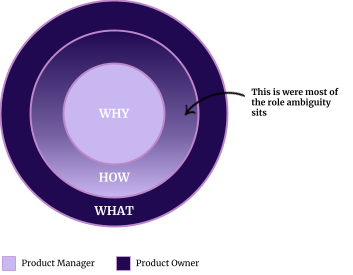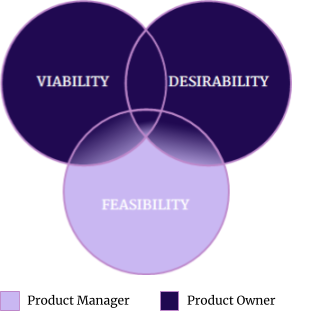Meet Janet, who was recently hired to be a new company’s first product manager. Janet will assume some accountabilities from the product owner, Noah.

On her first day of work, Janet meets Noah and the two engage in an intense stare-off. What follows is a period of fierce battles, confusion, misunderstandings, tears, and joy.
Not only are Janet and Noah impacted by storming, norming, and forming their newly established roles — so are all those involved in the product development process, including the customers.
The result? No clear product direction, an incomplete understanding of the user and their needs, vague requirements to resolve user pain points, unexpected costs, and unused features.
If only there were a way to avoid this.
Both the product manager and the product owner are critical to the success of the product. The definition of these two roles is often debated and the terms are sometimes used interchangeably. This can create tons of confusion and stress for those in the roles.
To make it even more confusing, in some companies, both positions are filled by the same person.
The product manager and product owner roles are mutually important, yet distinctly different. They work closely together to achieve their joint end goal, which is to build products that create meaningful value for their customers.
To avoid ambiguity, role clarity is key. There is nothing worse than role ambiguity, though there will always be some.
So what does each role entail? What are the responsibilities, key tasks to be executed, and skills needed to be successful?
Before diving into each role, let’s first take a bird’s eye view of the fundamental difference between the product manager and product owner roles.
To put it as simply as possible:
The product manager focuses on building the right product. The product owner focuses on building the product right.
Seems simple, right? Not so fast. While it’s easy to delineate between the role of the PM and PO at certain stages of the product lifecycle, in other areas, the responsibilities overlap and lines blur.
To illustrate the difference between product manager and product owner, we’ll look at the golden circle and three lenses of innovation models.
According to Simon Sinek’s book Start With Why, the golden circle model is perfectly applicable to product management. We start with why, move on to the how, and end with the what, answering questions at each step:

The product manager focuses on answering the why and how whereas the product owner contributes to the how and focuses on the what.
Both the product manager and product owner play an important role in the how. This is the battleground where accountability debates most often take place. One is expected to be more flexible, and the accountabilities vary.
Conceptualized by IDEO in the early 2000s, the three lenses of innovation is a design thinking methodology that helps distinguish between the focus of each role. The three lenses are defined as follows:

The product manager has to master the subtle art of balancing all three lenses. To answer the feasibility question, the product manager relies on the advice of the product owner, who works with the development team to define how to build the product right.
Now that we’ve defined the differences between the product manager and product owner’s roles, let’s dive into more detail around the responsibilities, tasks to be managed, and skills required to fulfill them.
| Product manager vs. product owner: Role and responsibilities | |
| Product manager | Product owner |
| Core business function | Assigned to a team |
| External focus | Internal focus |
| Strategic | Tactical |
| Long-term focus | Short-term activities |
| Market and customer needs | Development and implementation |
The product manager’s role is a strategic business function. The PM is responsible for clarifying the why and understanding the viability, desirability, and feasibility of all great ideas and opportunities presented.
The product manager facilitates a faster response to new market and product opportunities and is the single point of contact for client services.
The role is long-term focused and accountable for understanding the market, what users need, and why they need it. The PM prioritizes what outcomes are expected and determines what to build next, communicating objectives and plans to stakeholders and rallying all around the product roadmap.
The product owner, on the other hand, is assigned to a team (or multiple teams) and operates at a tactical level. The PO aims to maximize value through creating and managing the product backlog and acting as the voice of the customer.
The product owner role focuses on development and implementation through short-term activities and helping the product development team(s) understand what needs to be done. Basically, the PO’s job is set up the team to create a reliable, scalable, secure, and maintainable solution.
Zooming in further, let’s examine these responsibilities in the context of the various tasks each role manages.
| Product manager vs. product owner: Tasks to manage | |
| Product manager | Product owner |
| Owns relationship with the business and customer | Represents the voice of the customer |
| Owns product vision and roadmap | Contributes to product vision and roadmap |
| Owns program backlog | Owns team backlog(s) |
| Defines features and releases | Defines iterations and stories |
| Tracks market changes and trends | Accepts iterations increments |
The product manager has an external focus and is the single point of contact for managing the relationships with the business and customer.
Acting at a strategic level, the product manager owns the product vision and roadmap, discovers what the user needs, decides which outcomes to pursue next, and prioritizes features and releases accordingly in the program backlog.
To ensure the team is pursuing the right outcomes that bring the most value, the product manager is tasked with tracking market changes and trends and keeping a continuous eye on competition to uncover threats and opportunities.
Moreover, the product manager is accountable for establishing and tracking product metrics to validate expected outcomes or pivot when required.
The product owner has an internal focus and represents the voice of the customer to the development team(s).
Though the product manager owns the vision and roadmap, the product owner is a key partner and contributor in establishing both.
Whereas the product manager is responsible for the program backlog, the product owner oversees the development team’s backlog. The product owner has the most complete understanding of the solution and therefore is most qualified to assess feasibility and prioritizes stories to achieve the outputs.
Empowered by a prioritized team backlog, the product owner defines the iterations to realize the stories, tracks the progress of the delivery, and accepts the iteration increments.
To be an excellent product manager or product owner requires a mix of hard and soft skills, including proficiency in the following areas:
| Product manager vs. product owner: Skills required and importance of each skill | ||
| Skill | Product manager | Product owner |
| Business acumen | ⏺⏺⏺⏺⏺ | ⏺⏺⏺⏺ |
| Decision-making | ⏺⏺⏺⏺◖ | ⏺⏺⏺⏺ |
| Analytics | ⏺⏺⏺⏺⏺ | ⏺⏺⏺⏺◖ |
| Technical | ⏺⏺⏺⏺◖ | ⏺⏺⏺◖ |
| Communication | ⏺⏺⏺⏺⏺ | ⏺⏺⏺⏺⏺ |
| Project management | ⏺◖ | ⏺⏺◖ |
| Collaboration | ⏺⏺⏺◖ | ⏺⏺⏺⏺◖ |
Though skills related to all of the above are required for both roles, the way they are applied by product managers and product owners can vary.
A product manager needs to have exceptional business acumen to understand what the customer needs out of the product while bringing maximum value to the company. This person needs to have an affinity for the product, the market, and the target customer and a drive to continuously strive for a product advantage.
The product manager is data-influenced, experiment-driven, and customer-centric. On top of that, a product manager aims to be right as often as possible and needs to understand what is required to reach expected outcomes.
If a PM isn’t comfortable with data analytics and performance monitoring, there’s a good chance they’ll fail.
There will be many opportunities, and business stakeholders and customers will try to influence product direction. The product manager needs to have great collaboration skills (e.g., emotional control, behavior depiction, influencing, and stakeholder management) and excellent communication skills (e.g., empathy, showing understanding, and the ability to let someone down easy).
To ensure the right things are built and expected outcomes are realized, the product manager needs to have great decision-making skills. Decisions should be supported by data around innovation, strategy, and market conditions.
It is good for a product manager to have technical skills, yet this is more the domain of the product owner. For the PM role, great collaboration and communication skills and the ability to ask tough questions can make up for lack of technical acumen.
Product managers benefit from having project management skills — in other words, being a structured thinker and aware of risks, checking plans and tracking progress, making changes where needed, having organizational awareness, and pursuing what creates the most value (the business case).
The product owner should have some business sense, such as an ability to understand the market and user needs, but the PO doesn’t need to be completely business-savvy.
The product owner is tasked to create the product right. As such, they need to be able to work out how to create scalable, reliable, secure, and reusable components. Having very strong analytical skills is important in this endeavor.
The product owner represents the voice of the customer and must closely collaborate with both the product manager and development team. It is essential for the product owner to be able to speak in the parlance of both business and technology.
To ensure things are being built right, delivering individual value, and providing more with less, product owners need to have great decision-making skills.
The product owner doesn’t have to be a technical guru, but familiarity with architectures, coding languages, software delivery lifecycles, and delivery methodologies is a huge advantage.
Even more so than product managers, product owners benefit from having project management skills. Being structured and aware of risks, checking plans and tracking progress, making changes where needed, having organizational awareness, and delivering high-quality features are all crucial for the product owner.
There you have it, a comprehensive overview of why the product manager and product owner roles are critical to product success, what each focuses on, how they bring value to the product, and a list of skills required to be successful in each role.
The product manager is responsible for discovering what users require and why, prioritizing what to build next, and rallying the team around a product roadmap.
The product owner is responsible for maximizing the value of the product by creating and managing the delivery.
Further reading:
Featured image source: IconScout
LogRocket identifies friction points in the user experience so you can make informed decisions about product and design changes that must happen to hit your goals.
With LogRocket, you can understand the scope of the issues affecting your product and prioritize the changes that need to be made. LogRocket simplifies workflows by allowing Engineering, Product, UX, and Design teams to work from the same data as you, eliminating any confusion about what needs to be done.
Get your teams on the same page — try LogRocket today.

Christina Valls shares how her teams have transformed digital experiences at Cedars-Sinai, including building a digital scheduling platform.

Red-teaming reveals how AI fails at scale. Learn to embed adversarial testing into your sprints before your product becomes a headline.

Cory Bishop talks about the role of human-centered design and empathy in Bubble’s no-code AI development product.

Learn how to reduce mobile friction, boost UX, and drive engagement with practical, data-driven strategies for product managers.